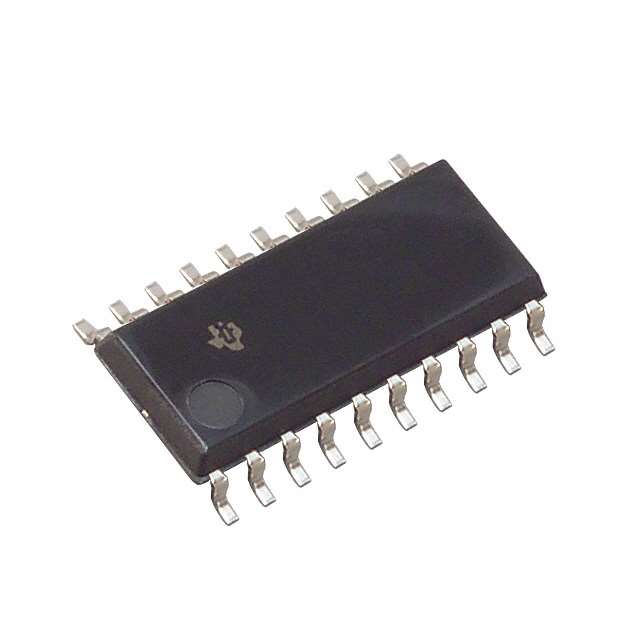CD74HC688NSR
Product Overview
- Category: Integrated Circuit
- Use: Arithmetic Logic Unit (ALU)
- Characteristics: High-speed, CMOS logic, 8-bit magnitude comparator
- Package: SOIC-20
- Essence: The CD74HC688NSR is a high-performance integrated circuit designed for digital arithmetic and logic operations. It is commonly used in applications that require comparison of two 8-bit binary numbers.
- Packaging/Quantity: The CD74HC688NSR is available in a standard SOIC-20 package and is typically sold in reels of 2500 units.
Specifications
- Supply Voltage: 2V to 6V
- Operating Temperature Range: -40°C to +85°C
- Propagation Delay: 9 ns (typical)
- Input Current: ±1µA (maximum)
- Output Current: ±25mA (maximum)
Detailed Pin Configuration
The CD74HC688NSR has a total of 20 pins, which are assigned specific functions as follows:
- A0: Input pin for the least significant bit (LSB) of the first 8-bit number.
- A1: Input pin for the second bit of the first 8-bit number.
- A2: Input pin for the third bit of the first 8-bit number.
- A3: Input pin for the fourth bit of the first 8-bit number.
- A4: Input pin for the fifth bit of the first 8-bit number.
- A5: Input pin for the sixth bit of the first 8-bit number.
- A6: Input pin for the seventh bit of the first 8-bit number.
- A7: Input pin for the most significant bit (MSB) of the first 8-bit number.
- B0: Input pin for the LSB of the second 8-bit number.
- B1: Input pin for the second bit of the second 8-bit number.
- B2: Input pin for the third bit of the second 8-bit number.
- B3: Input pin for the fourth bit of the second 8-bit number.
- B4: Input pin for the fifth bit of the second 8-bit number.
- B5: Input pin for the sixth bit of the second 8-bit number.
- B6: Input pin for the seventh bit of the second 8-bit number.
- B7: Input pin for the MSB of the second 8-bit number.
- G: Enable pin for the comparator.
- LT: Output pin indicating that A < B.
- EQ: Output pin indicating that A = B.
- GT: Output pin indicating that A > B.
Functional Features
- High-speed operation allows for efficient comparison of two 8-bit numbers.
- CMOS logic ensures low power consumption and compatibility with a wide range of digital systems.
- The CD74HC688NSR can be cascaded to compare larger binary numbers.
- The enable pin (G) provides control over the comparator's operation, allowing for flexibility in system design.
Advantages and Disadvantages
Advantages: - High-speed operation enables quick comparison of 8-bit numbers. - Low power consumption due to CMOS technology. - Compatibility with various digital systems. - Cascadable for comparing larger binary numbers.
Disadvantages: - Limited to 8-bit comparison, not suitable for larger data sizes. - Requires external control signal (enable pin) for proper operation.
Working Principles
The CD74HC688NSR utilizes a combination of digital logic gates to compare two 8-bit binary numbers. It performs a bit-by-bit comparison, starting from the most significant bit (MSB) down to the least significant bit (LSB). The comparator generates three output signals: LT (A < B), EQ (A = B), and GT (A > B), indicating the relationship between the two input numbers.
Detailed Application Field Plans
The CD74HC688NSR is commonly used in various applications that require the comparison of two 8-bit binary numbers. Some specific application fields include:
- Microcontrollers: Used for comparing data values in microcontroller-based systems.
- Digital Signal Processing: Enables efficient comparison of digital signals in DSP algorithms.
- Data Encryption: Utilized in cryptographic systems for comparing encryption keys.
- Industrial Automation: Used in control systems for comparing sensor readings or process variables.
- Communication Systems: Enables comparison of digital data packets in communication protocols.
Detailed and Complete Alternative Models
- SN74HC688N: Similar functionality and pin configuration, but available in a DIP-20 package.
- CD74HCT688E: Compatible with TTL logic
قم بإدراج 10 أسئلة وإجابات شائعة تتعلق بتطبيق CD74HC688NSR في الحلول التقنية
Sure! Here are 10 common questions and answers related to the application of CD74HC688NSR:
Q: What is CD74HC688NSR? A: CD74HC688NSR is a 8-bit magnitude comparator integrated circuit (IC) that compares two 8-bit binary numbers and determines their relationship.
Q: What is the operating voltage range for CD74HC688NSR? A: The operating voltage range for CD74HC688NSR is typically between 2V and 6V.
Q: How many inputs does CD74HC688NSR have? A: CD74HC688NSR has a total of 16 inputs, divided into two sets of 8 inputs each.
Q: Can CD74HC688NSR be used in both parallel and serial data applications? A: No, CD74HC688NSR is primarily designed for parallel data applications.
Q: What is the output format of CD74HC688NSR? A: CD74HC688NSR provides three outputs: A>B, A=B, and A<B, indicating the relationship between the two input numbers.
Q: What is the maximum frequency at which CD74HC688NSR can operate? A: CD74HC688NSR can typically operate at frequencies up to 25 MHz.
Q: Can CD74HC688NSR handle both positive and negative logic inputs? A: Yes, CD74HC688NSR can handle both positive and negative logic inputs.
Q: Is CD74HC688NSR suitable for battery-powered applications? A: Yes, CD74HC688NSR is suitable for battery-powered applications as it operates at low power consumption levels.
Q: Can CD74HC688NSR be cascaded to compare larger binary numbers? A: Yes, multiple CD74HC688NSR ICs can be cascaded together to compare larger binary numbers.
Q: What is the package type for CD74HC688NSR? A: CD74HC688NSR is available in a small-outline integrated circuit (SOIC) package.
Please note that these answers are general and may vary depending on the specific datasheet and manufacturer's specifications for CD74HC688NSR.


